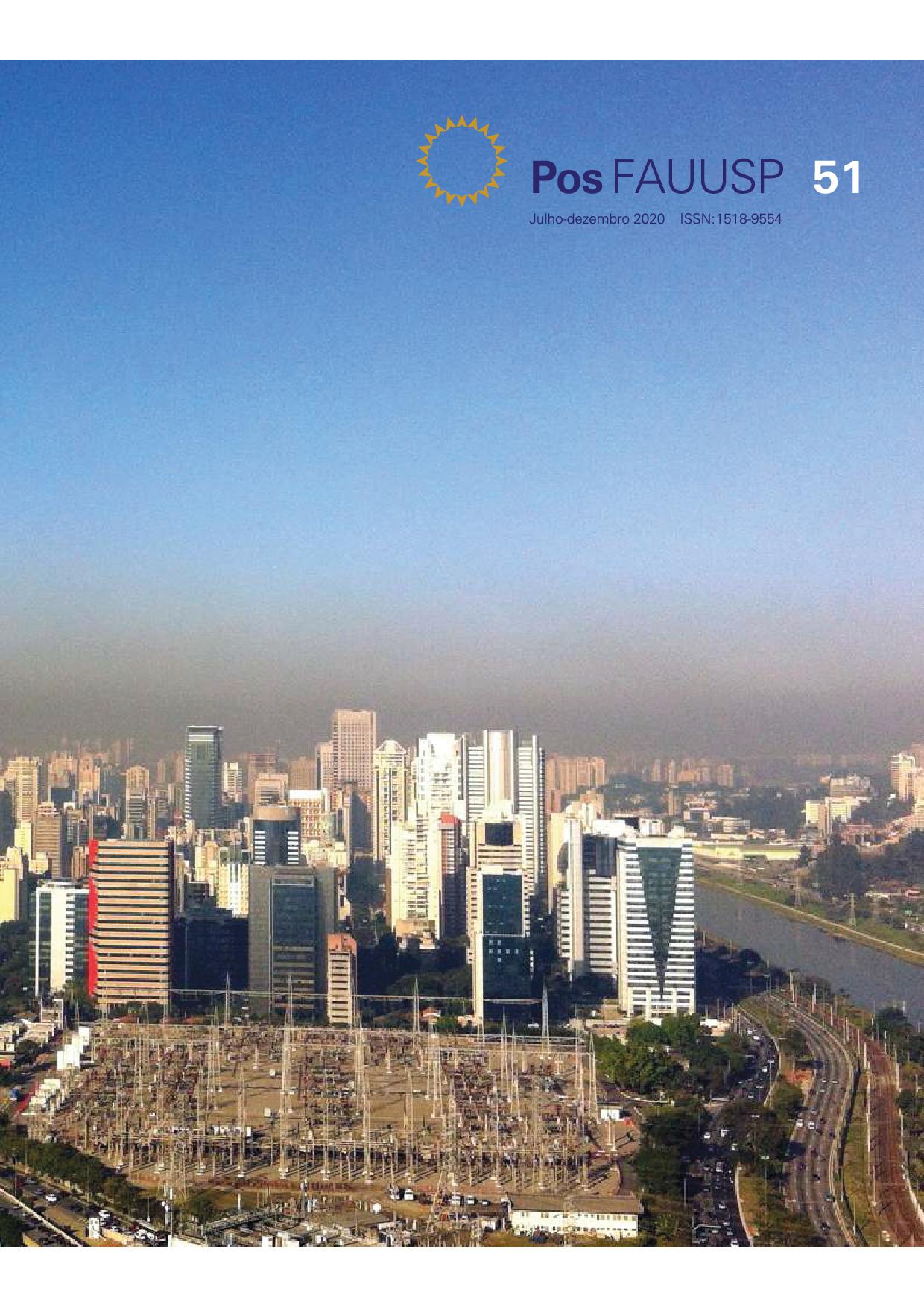Simplified method based on the diffuse light availability to estimate the buildings daylight harvesting potential
DOI:
https://doi.org/10.11606/issn.2317-2762.posfau.2020.168249Keywords:
Daylight, Difuse daylight illuminance, Lighting energy consumption, Simplified methodAbstract
This study aimed on verifying the application of the simplified method on different scenarios and checking its accuracy relative to the computer simulation regarding the lighting consumption economy due to daylight use. For this, we evaluated the results obtained from the computer simulation from six case studies with the proposed method. The case studies were evaluated assuming three different distribution for the lighting sensors, two environment types and two opening dimensions, all referring to the city of Florianopolis, Santa Catarina. The validity of choosing a single point was tested, located in the lower daylight portion of the sensor influence area, to verify the method's potential of estimating the autonomy of daylight as well as the lighting's energy consumption. The results showed that choosing the point with least light availability was valid, and it is recommended further studies to verify the limits of the method's application. It was also pointed out the tendency to underestimate the use of daylight, with some exceptions, depending on the orientation and the size of the opening.
Downloads
References
ASHRAE. Standard 90.1: Energy Standard for Buildings Except Low-Rise Residential Buildings I. Ansi/Ashrae/Ies- American Society of Heating Refrigeration and Air-Conditioning Engineers. 90.1. Atlanta. 2016.
ASSOCIAÇÃO BRASILEIRA DE NORMAS TÉCNICAS. ABNT NBR 15575-1: Edifícios habitacionais de até cinco pavimentos – Desempenho – Parte 1: Requisitos gerais. Rio de Janeiro, 2013.
ABNT NBR ISO/CIE 8995-1: 2013 Iluminação de ambientes de trabalho- Parte 1: Interior. Associação Brasileira De Normas Técnicas. Rio de Janeiro. N. 46.2013.
MARSH, A. Dynamic Daylighting. v. 2.0.2016.
CALIFORNIA ENERGY COMISSION. TITLE 24 - 2016 Building Energy Efficiency Standards for Residential and Nonresidential Buildings CEC-400-2012-004-CMF-REV2.California Energy Commission. Part 1. 2016.
CIBSE. Lighting Guide 10: Daylighting and Window Design. Chartered Institution of Building Services Engineers. Londres. 1999. 88 p.
EDWARDS, L.; TORCELLINI, P. A Literature Review of the Effects of Natural Light on Building Occupants. National Renewable Energy Laboratory. Golden, Colorado: 2002. 2002, 54 p. (NREL/TP-550-30769)
EUROPEAN COMMITTEE FOR STANDARDIZATION – CEN. CEN TC 169 WG 11 – Daylight: Daylight in buildings. European Standards. CEN/TC 169. Date: 2017-07.TC 169 WI 00169068.Secretariat: DIN. 2017
AUTORES; 2019.
INMETRO. CONSULTA PÚBLICA. Aperfeiçoamento do Regulamento Técnico da Qualidade para a Classe de Eficiência Energética de Edifícios Comerciais, de Serviços e Públicos. Ministério do Desenvolvimento. Portaria n.º 248. INMETRO, 2018.
INMETRO. Requisito técnico da qualidade para o nível de eficiência energética de edifícios comerciais, de serviços e públicos. I. E. C. E. Ministério Do Desenvolvimento. 2Rule.Portaria n. 372.INMETRO. N. 87.2010.
KENNEY, M.; BIRD, H. and ROSALES, H. 2019 California Energy Efficiency Action Plan. California Energy Commission. Publication Number: CEC400-2019-010-SF, 37p.
LABORATÓRIO DE EFICIÊNCIA ENERGÉTICA EM EDIFICAÇÕES. Arquivos climáticos. Disponível em: http://www.labeee.ufsc.br/downloads/arquivos-climaticos/inmet2018 Acesso em: dezembro de 2018.
MARDALJEVIC, J. Simulation of annual daylighting profiles for internal illuminance. Lighting Research and Technology, v. 32(3), p.111-118, 2000.
DOI: https://doi.org/10.1177%2F096032710003200302
MARDALJEVIC, J. and CHRISTOFFERSEN, J., `Climate connectivity' in the daylight factor basis of building standards. Building and Environment, v. 113, p. 200-209, 2017.
DOI: https://doi.org/10.1016/j.buildenv.2016.08.009
MAYHOUB, M. S.; CARTER, D. J. The costs and benefits of using daylight guidance to light office buildings. Building and Environment, v. 46, n. 3, p. 698-710. 2011.
DOI: https://doi.org/10.1016/j.buildenv.2010.09.014
MORAES, L. N. Estudo comparativo de sistemas de iluminação artificial com diferentes luminárias considerando a disponibilidade de luz natural. Florianópolis, 2012. Dissertação (Mestrado em Arquitetura e Urbanismo) - Escola de Arquitetura, Universidade Federal de Santa Catarina, Florianópolis, 2012.
PARISE, G.; MARTIRANO, L. and PARISE, L. A Procedure to Estimate the Energy Requirements for Lighting. In: IEEE Transactions on Industry Applications; 2016, Jan./Feb, 52 (1): 34-41.
D.O.I. 10.1109/TIA.2015.2463761
REINHART, C. F.; HERKEL, S. The simulation of annual daylight illuminance distributions - a state-of-the-art comparison of six RADIANCE-based methods. Energy and Buildings, v. 32(2), p.167-187, 2000.
DOI: https://doi.org/10.1016/S0378-7788(00)00042-6
REINHART, C. F.; LOVERSO, V. R. M. A rules of thumb-based design sequence for diffuse daylight. Lighting Research & Technology, v. 42, n. 1, p. 7-31. 2010.
DOI: 10.1177/1477153509104765
ROCHA, A. P. de A. Análise da Influência do Zoneamento da Iluminação Natural no Uso da Iluminação Artificial em Edifícios de Escritórios. Florianópolis, 2012. Dissertação (Mestrado em Arquitetura e Urbanismo) - Escola de Arquitetura, Universidade Federal de Santa Catarina, Florianópolis, 2012.
SOLEMMA LLC. DIVA for Rhino: Environmental Analysis for Buildings. v. 2.0.DIVA-for-Rhino é um plug-in de modelagem de iluminação natural e energia altamente otimizado para o modelador Rhinoceros - NURBS.2014.
VELUX. Daylight Visualizer. v. 2.0.2009.
Downloads
Published
Issue
Section
License
Copyright (c) 2020 Suelem Schier de França, Raphaela Walger da Fonseca, Fernando Oscar Ruttkay Pereira

This work is licensed under a Creative Commons Attribution 4.0 International License.

This work is licensed under a Creative Commons Attribution 4.0 International License.
DIADORIM - Diretório de Políticas Editoriais












